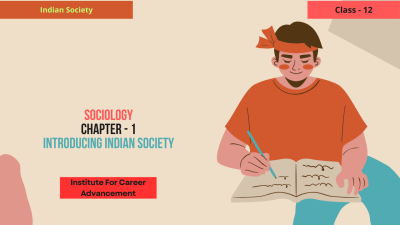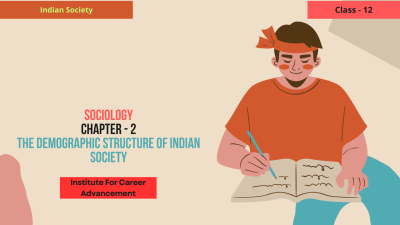Cultural Change - Class 12
Cultural change refers to the alteration of societal norms, values, beliefs, and behaviors over time. It can be influenced by various factors, including globalization, technological advancements, social movements, and economic development. Key Topics: Definition and Causes of Cultural Change: Understanding the concept of cultural change and the factors that drive it. Cultural Diffusion: The spread of cultural elements from one society to another. Acculturation: The process of adopting the cultural traits of another group. Cultural Resistance: The efforts of individuals or groups to preserve their cultural identity in the face of change. Cultural Imperialism: The imposition of one culture on another, often by a dominant power. Cultural Revitalization: Efforts to revive or preserve a declining culture. Learning Objectives: Understand the concept of cultural change and its significance. Analyze the factors that contribute to cultural change. Evaluate the impact of cultural change on individuals and societies. Explore the challenges and opportunities associated with cultural diversity and change. Develop critical thinking and problem-solving skills related to cultural issues. Cultural Change is a valuable course that provides students with a comprehensive understanding of the dynamics of cultural change. It equips them with the knowledge and skills necessary to analyze cultural trends, evaluate the impact of cultural change, and contribute to fostering cultural understanding and tolerance. সাংস্কৃতিক পরিবর্তন বলতে সময়ের সাথে সাথে সামাজিক রীতিনীতি, মূল্যবোধ, বিশ্বাস এবং আচরণের পরিবর্তনকে বোঝায়। এটি বিশ্বায়ন, প্রযুক্তিগত অগ্রগতি, সামাজিক আন্দোলন এবং অর্থনৈতিক উন্নয়ন সহ বিভিন্ন কারণ দ্বারা প্রভাবিত হতে পারে। মূল বিষয়ঃ সাংস্কৃতিক পরিবর্তনের সংজ্ঞা ও কারণঃ সাংস্কৃতিক পরিবর্তনের ধারণা এবং এটিকে চালিত করার কারণগুলি বোঝা। সাংস্কৃতিক বিস্তারঃ এক সমাজ থেকে অন্য সমাজে সাংস্কৃতিক উপাদানের বিস্তার। সংস্কৃতিঃ অন্য গোষ্ঠীর সাংস্কৃতিক বৈশিষ্ট্যগুলি গ্রহণ করার প্রক্রিয়া। সাংস্কৃতিক প্রতিরোধঃ পরিবর্তনের মুখে তাদের সাংস্কৃতিক পরিচয় সংরক্ষণের জন্য ব্যক্তি বা গোষ্ঠীর প্রচেষ্টা। সাংস্কৃতিক সাম্রাজ্যবাদঃ প্রায়শই একটি প্রভাবশালী শক্তি দ্বারা এক সংস্কৃতির উপর অন্য সংস্কৃতির চাপিয়ে দেওয়া। সাংস্কৃতিক পুনরুজ্জীবনঃ ক্রমহ্রাসমান সংস্কৃতিকে পুনরুজ্জীবিত বা সংরক্ষণের প্রচেষ্টা। শেখার উদ্দেশ্যঃ সাংস্কৃতিক পরিবর্তনের ধারণা এবং এর তাৎপর্য বুঝুন। সাংস্কৃতিক পরিবর্তনে অবদান রাখার কারণগুলি বিশ্লেষণ করুন। ব্যক্তি ও সমাজের উপর সাংস্কৃতিক পরিবর্তনের প্রভাব মূল্যায়ন করুন। সাংস্কৃতিক বৈচিত্র্য এবং পরিবর্তনের সঙ্গে যুক্ত চ্যালেঞ্জ এবং সুযোগগুলি অন্বেষণ করুন। সাংস্কৃতিক বিষয় সম্পর্কিত সমালোচনামূলক চিন্তাভাবনা এবং সমস্যা সমাধানের দক্ষতা বিকাশ করুন। সাংস্কৃতিক পরিবর্তন একটি মূল্যবান কোর্স যা শিক্ষার্থীদের সাংস্কৃতিক পরিবর্তনের গতিশীলতা সম্পর্কে ব্যাপক ধারণা প্রদান করে। এটি তাদের সাংস্কৃতিক প্রবণতা বিশ্লেষণ, সাংস্কৃতিক পরিবর্তনের প্রভাব মূল্যায়ন এবং সাংস্কৃতিক বোঝাপড়া ও সহনশীলতা বৃদ্ধিতে অবদান রাখার জন্য প্রয়োজনীয় জ্ঞান ও দক্ষতার সাথে সজ্জিত করে।
English
Last updated
Wed, 27-Nov-2024



















